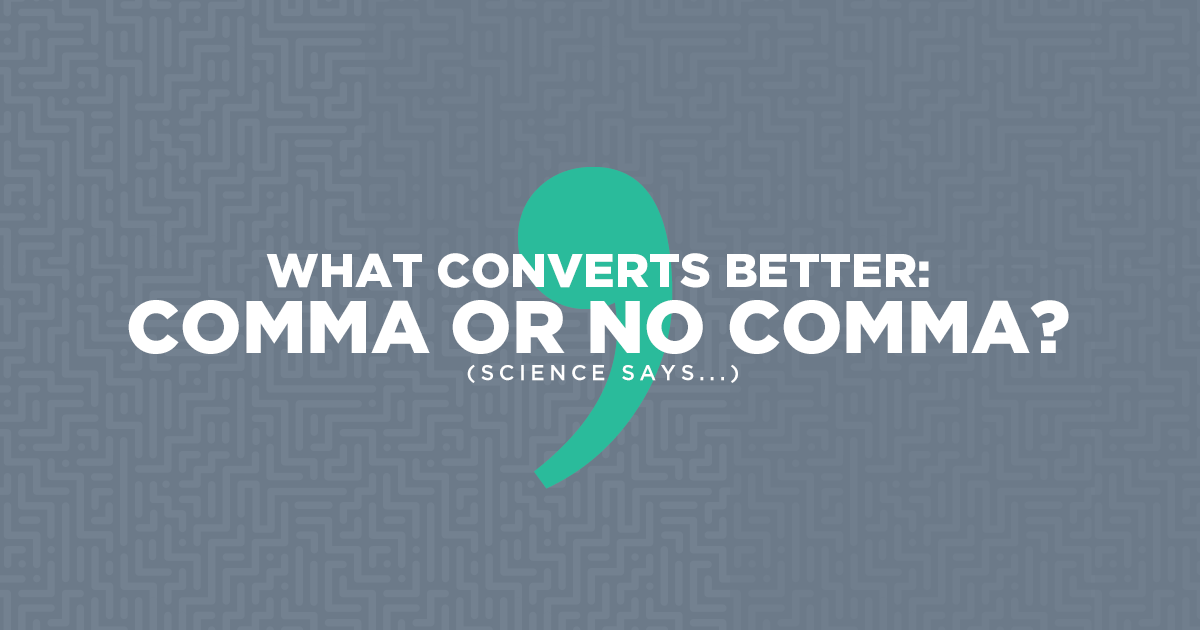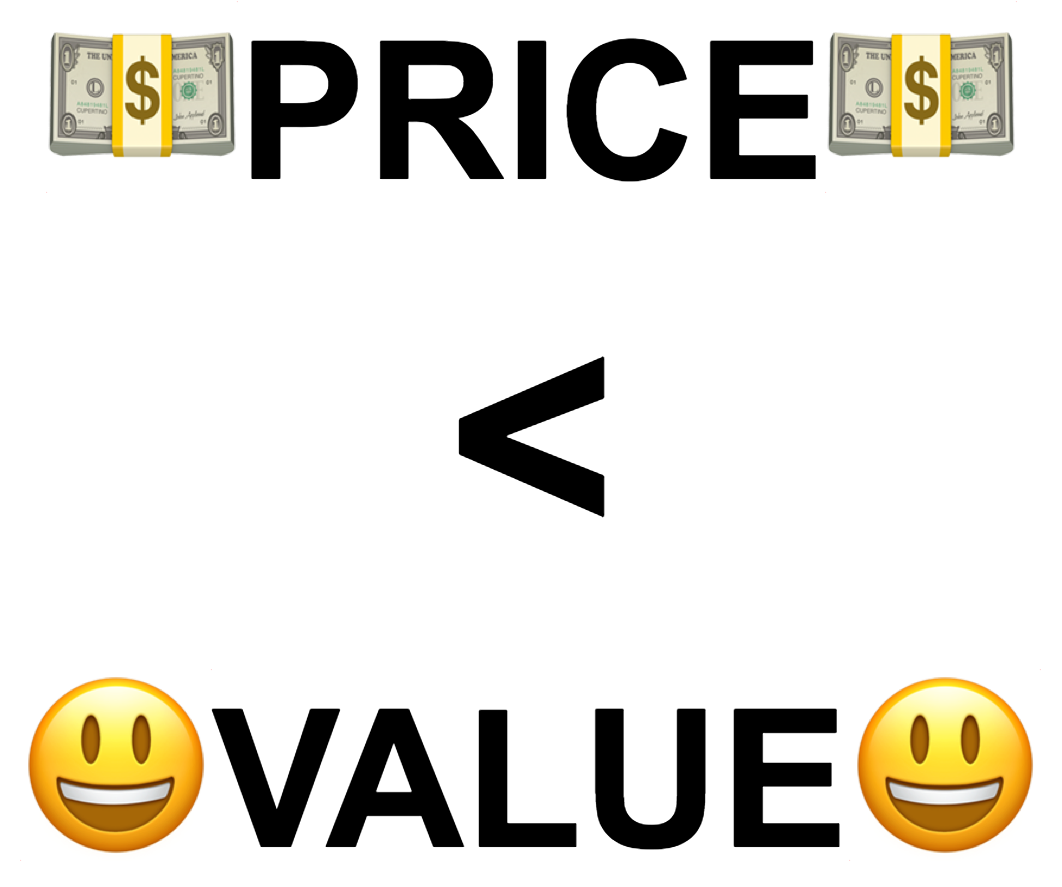
So, you want to know what converts better? $1,499 or $1499? Or in other words, you want to know if a comma impacts the way people perceive your price?
Well…
Here’s how selling works:
First, you make an offer.
Then, potential buyers look at the VALUE and the PRICE of your offer.
And they compare the two:

If the value is greater than the price, they buy.
If the value is lower than the price, they don’t buy.
Simple.
BUT there’s more to it…
#1 The Golden Rule of Pricing: Value Is AlL About Perception
Some people think it’s worth it to buy ridiculous amounts of sparkling water with almost NO flavor. Ridiculous!
Some people spend $400 on sneakers, but won’t spend an extra $2 for softer toilet paper. Also Ridiculous!
The point is:
Value is in the eye of the beholder.
And pricing isn’t as simple as “is it worth it or is it not?”
Of course, if you’re selling anything, it’s YOUR JOB to communicate the value of your product or service.
In fact, this is your FIRST job:
You want to make the perceived-value bar as high as possible.
However, there’s a flipside, because…
Price is about perception, too.
So, instead of increasing the perceived value, you can also LOWER the perceived price.
Notice how I didn’t say lower your price. I said, lower the perceived price.
Nothing revolutionary here either, I know.
Now, I’ve talked about choosing a price to optimize conversions before…
…but did you know that you can change the perception of your price with a tweak so simple it only takes about 2 seconds?
The best part?
You don’t have to change your price. You just have to change how you PRESENT it…
I’ll explain.
In a study published in the Journal of Consumer Psychology, researchers tested different price formats.
Specifically, they tested “$1,499” against “$1499”. So, the first format included a comma. The second format had no comma.
Then, the researchers asked people to say these prices out loud. And here’s what happened:
When people read the price without the comma, 93% of them said “fourteen ninety-nine.”
When they read the price WITH the comma, 84% of people said “one thousand four hundred and ninety-nine.”
Interesting, right?
What’s happening is this:
With the comma, people frame it as a “thousand-something” price. Without the comma they think of the price in “hundreds.” And they SAY it differently…
This is important, because WITH the comma, it takes more syllables to say the price. And, as the researchers found, this makes the price seem higher!
Plus, the price with the comma looks bigger on paper or on the screen, simply because it’s takes up more visual space, too.
Pretty crazy…
The way we see a price, changes the way we think about a price, which changes the way we say a price, which changes how we assess a price!
The good news is that the lesson here is straightforward:
Don’t put a comma in your price!
And people will perceive the price to be lower.
However, be careful. There’s ONE caveat…
Things might change if you’re selling an offer in the six-figures, like real estate. Maybe even in the high 4- and 5-figures.
In these cases, leaving out the comma, is likely to be counterproductive.
Why?
Because now the price gets difficult to read. There are just too many digits.
But if you’re selling a product in the one-thousand to three-thousand dollar range, leaving out the comma is a smart tweak.
Finally, one more thing about formatting your prices:
The same study that tested commas, also tested prices with and without DECIMALS.
So, for example, “1,499.00” versus “1,499”.
But the results here are a little harder to interpret. Especially because there’s a lot of evidence that prices ending in 99 cent prices convert better…
However, here’s what I can tell you:
You definitely shouldn’t add decimals with no value, like two zeros. That just takes up more space, and makes the price look bigger than it needs to.
Cool? Cool.
So remember:
Kill the commas and decimals in your prices if you don’t need them.
Now, I know you may be tempted to “Split test pricing,” but I would highly discourage it. I even warn you about why I hate split testing right here.
In the end, a comma or no comma won’t make or break your business.
Now…
If you liked this video, make sure you check out my other videos on pricing.
For example, have you ever wondered what converts better between, $100, $99, and $97 dollars? We’ll I’ve got the answer for you here:








Hey Derek,
Good afternoon. Lovely writing as ever. i always enjoy and learn reading through this website.
As much as i want to believe on the customer perception about high and low end values; would not you agree that the more explicit the price is the more brand equity it creates. Thus, translating into better conversion, in-fact more sustained conversion.
Cheers. Have an awesome weekend.
Hello from beautiful Montana, USA
Thanks for caring and sharing this information. Isn’t it interesting how humans perceive things differently? I really liked the comment about spending an extra $2 for toilet paper. Just did that yesterday even though I had just bought a cashmere sweater that was on sale for $59 and was feeling proud of my shopping skills.
Crazy, huh?
Judy Helm Wright–Author/Blogger/Intuitive Wise Woman
You answered my question on the use of this on large numbers such as a house selling price.
Although I worry about someone who’d get lost in $545500.
Maybe they’d like $545499?
Completely agree with you, Derek, that perception is what drives the buying process. So, along those lines, I have a question for you…
Sometimes, when the price is higher, the perception is that the item being sold has a greater value. So, if you want to give the perception of higher value, wouldn’t it be better to leave the comma in? Just playing devil’s advocate here. Curious to read your reply! Thanks!
Well done; and, perhaps [perception being what it is] more importantly, well presented. Thank you.
Great insight and psychology shared in this post. Perception IS reality for most people so knowing how to format pricing impacts profits. I recently shared the .99 cent advice with a psychology student last week. He seemed surprised by it. I informed him psychology plays a huge role in buying habits and maybe he should consider thinking out of the box on what he could do with his psychology degree once he finished school.
Great article. Before even posting my comment, I went to remove my commas. Thanks!
This is interesting and taps into a lot of the thinking in Dan Ariely’s new book Dollars and Sense. I think copywriters would do well to study the psychology behind pricing vs. value. Great read.
Love the Zippy Engage thing you’re using. Where do I get it? Is it a beta thing you are working on?
Very interesting. Thanks. By that merit, if you’re trying to look stylish and exclusive/expensive, I wonder if you should choose the comma over the non-comma option?!
Amazing, I never thought that a COMMA can make huge difference in website conversion. I’d also like you publish the article what people think when they PRICE is 99 instead of 100. What is the science behind it?
Thanks,
Umesh Singh
Hey, Derek, your split testing link seems to be broken. You meant to link to https://socialtriggers.com/split-testing-software-waste/? 😛
Thank you Derek. That’s interesting stuff.
The other day I was reading a study (by Monica Wadhwa and Kuangjie Zhang) that showed there’s a difference between logical vs emotional purchases.
Apparently prices that are rounded perform better for emotional purchases, while prices with decimals perform better for logical purchases.
Luxury items with a rounded price tag just ‘feel right’, for some reason.